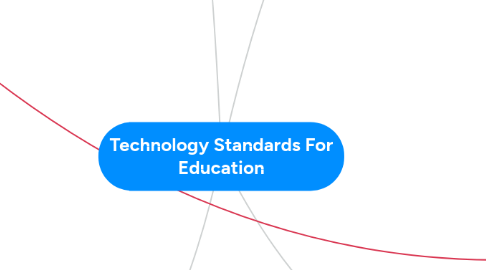
1. ISTE Standards for Students
1.1. Digital Citizen
1.1.1. To use technology in a responsible and appropriate manner
1.2. Empowered Learner
1.2.1. Being an active learning and demonstrating skills using technology to enriching their learning experience
1.3. Knowledge Constructor
1.3.1. Use of technology to learn new things and further explore and discover the world
1.4. Innovative Designer
1.4.1. Solving, creating and imagining problems and solutions with digital tools
1.5. Computational Thinker
1.5.1. Ability to problem solve and make informed decisions using logical and an analytical reasoning while using technology
2. ICT Programs of Study
2.1. Communicating and Inquiring with Technology
2.1.1. Devolving the skills to effectively communicate on digital devices and develop skills to question perspectives and viewpoints that technology brings to the table
2.2. Decision Making and Problem Solving
2.2.1. Using technology and digital tools to build upon and improve decision making and problem solving skills
2.3. Foundation Operations
2.3.1. Gaining the fundamental skills surrounding using and embracing technology in the learning atmosphere
2.4. Knowledge and Concepts
2.4.1. Students will be able to demonstrate and apply the appropriate the knowledge and concepts of technology they are interacting with for their development level
2.5. Processes for Productivity
2.5.1. Students will be able to use, apply and connect with different types of technological mediums in a practical way that is related to what they are learning in the classroom
3. ISTE Standards for Teachers
3.1. Promote and Model Digital Citizenship and Responsibility
3.1.1. Practice digital citizenship by being aware of your digital footprint both personally and professionally
3.2. Facilitate and Inspire Student Creativity and learning
3.2.1. Use technology in way that will promote student engagement and give students opportunities to be creative with their learning
3.3. Design and Devolp Digital Age Learning Experiences and Assessments
3.3.1. Give students the opportunity to be exposed to technology and learn in different ways with digital tools
3.4. Model Digital Age Work and Learning
3.4.1. Be knowledgeable about material being taught but also demonstrate knowledge and skills with the digital tools being used.
3.5. Engage in Professional Growth and Leadership
3.5.1. Technology is constantly changing and evolving, be a life long learner and have a focus of trying to learn how you as a professional continue to grow your digital skills
4. Learning and Technology Policy Framework
4.1. Student Centered Learning
4.1.1. Using technology in a way that will enrich the learning experience for the student and will lead to more well rounded learners
4.2. Research and Innovation
4.2.1. Evolving with technology and giving students opportunities to be innovative with technologies
4.3. Professional Learning
4.3.1. Being a lifelong learner and continually taking part in opportunities for both professional or person growth with technology
4.4. Leadership
4.4.1. Use technology in a way that is innovative, effective and engages the students. Set an example for how technology can be used
4.5. Access, Infrastructure and Digital Learning Enviroments
4.5.1. Ensure that technology is available and be a advocate to have reliable and relevant technology avaliable
